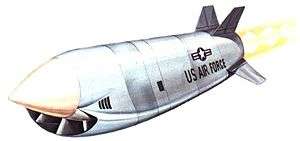ASALM
The Advanced Strategic Air-Launched Missile (ASALM) was a medium-range strategic missile program, developed in the late 1970s for the United States Air Force. Intended for use in both the air-to-surface and anti-AWACS roles, the missile's development reached the stage of propulsion-system tests before being cancelled in 1980.
| ASALM | |
|---|---|
 Martin Marietta ASALM | |
| Type | Air-to-surface missile |
| Place of origin | United States |
| Service history | |
| Used by | United States Air Force |
| Specifications | |
| Mass | 2,700 pounds (1,200 kg) |
| Length | 14 feet (4.3 m) |
| Warhead | W69 thermonuclear |
| Blast yield | 200 kilotonnes of TNT (840 TJ) |
| Engine | Marquardt rocket/ramjet |
Operational range | 300 miles (480 km) |
| Maximum speed | Mach 4.5+ |
Guidance system | Inertial + passive antiradiation and active radar homing for air-to-air mode[1] |
Design and development
Development of the Advanced Strategic Air-Launched Missile was initiated in 1976.[2] The ASALM was intended to replace the AGM-69 SRAM in United States Air Force service, providing improved speed and range over the earlier missile,[2] as well as improved performance against hardened targets.[3] In addition, the requirement specified that the ASALM should be capable of operating in a secondary air-to-air mode against AWACS radar-warning aircraft.[2] Martin Marietta and McDonnell Douglas submitted proposals for the contract, the former's design using a Marquardt propulsion system; the latter's, one developed by United Technologies Corporation; the Martin Marietta design was favored by the Air Force[2]
The size of ASALM was limited by the requirement that it use the same launchers as the earlier SRAM.[2] The missile would be steered by small fins at the tail, but lacked wings; the shape of the body combined with the high flight speed were to provide sufficient lift.[4]
Guidance was planned to be provided during mid-course flight by an inertial navigation system, while terminal guidance would use a dual-mode seeker.[2] Propulsion would be provided by an integrated rocket-ramjet, which would act as a solid-fuel rocket during boost, with the rocket's casing, following exhaustion of its propellant and the ejection of the rocket nozzle and a fairing covering an air inlet, becoming a combustion chamber for an air-breathing ramjet,[5] which was planned to use Shelldyne-H fuel.[4] The missile was expected to be carried by the B-1 bomber, or alternatively by a developed version of the FB-111.[5]
Operational history

Starting in October 1979, a series of flight tests of Propulsion Technology Validation missiles, using a Marquardt rocket-ramjet, were conducted.[2] Over the course of seven test firings, a maximum speed of Mach 5.5 at an altitude of 40,000 feet (12,000 m) was achieved.[2]
Despite the successful testing, the ASALM program was suspended following the seventh PTV test flight in May 1980;[2] reductions in the defense budget, combined with the development of the subsonic AGM-86 ALCM,[2] led to the cancellation of the program later that year.[4]
The Martin Marietta ASALM concept was later developed into the AQM-127 SLAT target drone.[2]
See also
- Air-Launched Cruise Missile
- BrahMos
- Creative Research On Weapons
References
Notes
- https://media.defense.gov/2017/Apr/07/2001728474/-1/-1/0/B_0006_WERRELL_EVOLUTION_CRUISE_MISSILE.PDF
- Parsch 2003
- Gunston 1983, p.88.
- Aldridge 1983, pp.150-151.
- Dornan 1978, p.222.
Bibliography
- Parsch, Andreas (2003). "Martin Marietta ASALM". Directory of U.S. Military Rockets and Missiles. designation-systems.net. Archived from the original on 15 December 2010. Retrieved 31 December 2010.
- Aldridge, Robert C. (1999). First Strike! The Pentagon's Strategy for Nuclear War. Boston: South End Press. ISBN 0-89608-154-0.
- Dornan, Dr. James E., Jr., ed. (1978). The US War Machine. London: Salamander Books. ISBN 0-517-53543-2.
- Gunston, Bill (1983). An Illustrated Guide to Modern Airborme Missiles. London: Salamander Books. ISBN 978-0-86101-160-5.